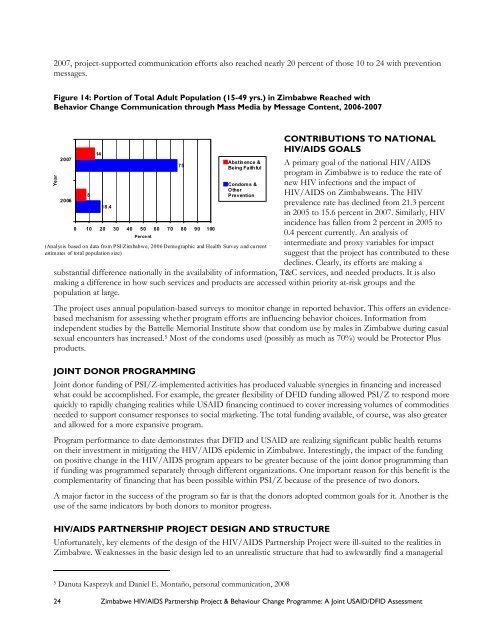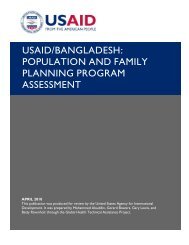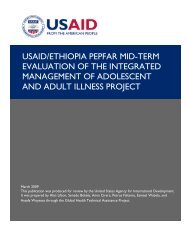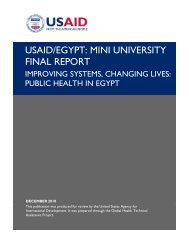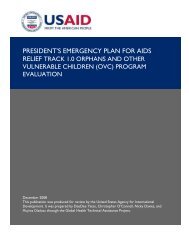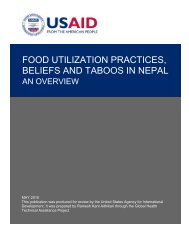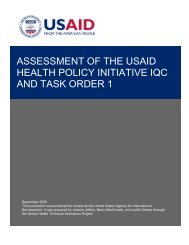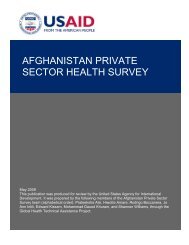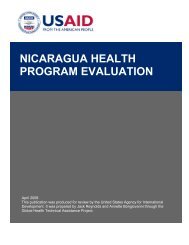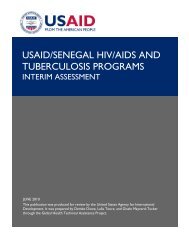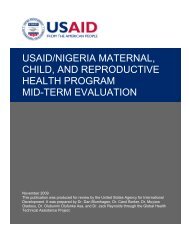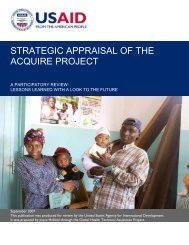Zimbabwe HIV/AIDS Partnership Project & Behaviour Change
Zimbabwe HIV/AIDS Partnership Project & Behaviour Change
Zimbabwe HIV/AIDS Partnership Project & Behaviour Change
- No tags were found...
Create successful ePaper yourself
Turn your PDF publications into a flip-book with our unique Google optimized e-Paper software.
2007, project-supported communication efforts also reached nearly 20 percent of those 10 to 24 with preventionmessages.Figure 14: Portion of Total Adult Population (15-49 yrs.) in <strong>Zimbabwe</strong> Reached withBehavior <strong>Change</strong> Communication through Mass Media by Message Content, 2006-2007Year2007200681418.40 10 20 30 40 50 60 70 80 90 100Percent75Abstinence &Being Faith fulCondoms &OtherPrevention(Analysis based on data from PSI/<strong>Zimbabwe</strong>, 2006 Demographic and Health Survey and currentestimates of total population size)CONTRIBUTIONS TO NATIONAL<strong>HIV</strong>/<strong>AIDS</strong> GOALSA primary goal of the national <strong>HIV</strong>/<strong>AIDS</strong>program in <strong>Zimbabwe</strong> is to reduce the rate ofnew <strong>HIV</strong> infections and the impact of<strong>HIV</strong>/<strong>AIDS</strong> on <strong>Zimbabwe</strong>ans. The <strong>HIV</strong>prevalence rate has declined from 21.3 percentin 2005 to 15.6 percent in 2007. Similarly, <strong>HIV</strong>incidence has fallen from 2 percent in 2005 to0.4 percent currently. An analysis ofintermediate and proxy variables for impactsuggest that the project has contributed to thesedeclines. Clearly, its efforts are making asubstantial difference nationally in the availability of information, T&C services, and needed products. It is alsomaking a difference in how such services and products are accessed within priority at-risk groups and thepopulation at large.The project uses annual population-based surveys to monitor change in reported behavior. This offers an evidencebasedmechanism for assessing whether program efforts are influencing behavior choices. Information fromindependent studies by the Battelle Memorial Institute show that condom use by males in <strong>Zimbabwe</strong> during casualsexual encounters has increased. 5 Most of the condoms used (possibly as much as 70%) would be Protector Plusproducts.JOINT DONOR PROGRAMMINGJoint donor funding of PSI/Z-implemented activities has produced valuable synergies in financing and increasedwhat could be accomplished. For example, the greater flexibility of DFID funding allowed PSI/Z to respond morequickly to rapidly changing realities while USAID financing continued to cover increasing volumes of commoditiesneeded to support consumer responses to social marketing. The total funding available, of course, was also greaterand allowed for a more expansive program.Program performance to date demonstrates that DFID and USAID are realizing significant public health returnson their investment in mitigating the <strong>HIV</strong>/<strong>AIDS</strong> epidemic in <strong>Zimbabwe</strong>. Interestingly, the impact of the fundingon positive change in the <strong>HIV</strong>/<strong>AIDS</strong> program appears to be greater because of the joint donor programming thanif funding was programmed separately through different organizations. One important reason for this benefit is thecomplementarity of financing that has been possible within PSI/Z because of the presence of two donors.A major factor in the success of the program so far is that the donors adopted common goals for it. Another is theuse of the same indicators by both donors to monitor progress.<strong>HIV</strong>/<strong>AIDS</strong> PARTNERSHIP PROJECT DESIGN AND STRUCTUREUnfortunately, key elements of the design of the <strong>HIV</strong>/<strong>AIDS</strong> <strong>Partnership</strong> <strong>Project</strong> were ill-suited to the realities in<strong>Zimbabwe</strong>. Weaknesses in the basic design led to an unrealistic structure that had to awkwardly find a managerial5 Danuta Kasprzyk and Daniel E. Montaño, personal communication, 200824 <strong>Zimbabwe</strong> <strong>HIV</strong>/<strong>AIDS</strong> <strong>Partnership</strong> <strong>Project</strong> & <strong>Behaviour</strong> <strong>Change</strong> Programme: A Joint USAID/DFID Assessment


